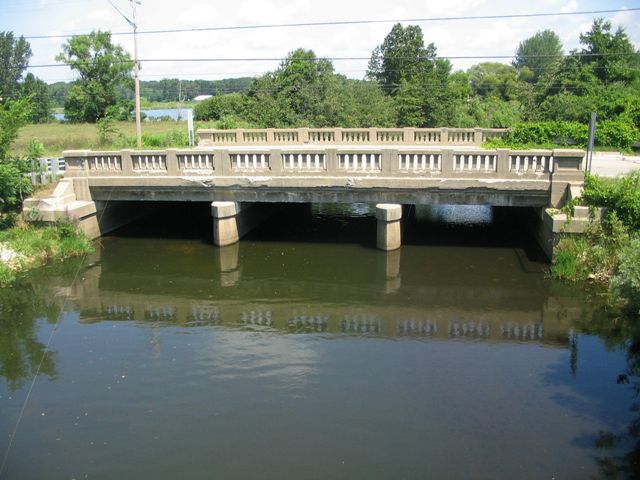We Recommend:
Bach Steel - Experts at historic truss bridge restoration.
BridgeHunter.com Phase 1 is released to the public! - Visit Now
Airline Road Bridge

Primary Photographer(s): Randy Mulder
Bridge Documented: August 5, 2010
Norton Shores: Muskegon County, Michigan: United States
1931 By Builder/Contractor: Price Brothers Company of Lansing, Michigan
Not Available or Not Applicable
20.0 Feet (6.1 Meters)
60.0 Feet (18.3 Meters)
40 Feet (12.19 Meters)
3 Main Span(s)
614487100056B01

View Information About HSR Ratings
Bridge Documentation
View Archived National Bridge Inventory Report - Has Additional Details and Evaluation
The Airline Road Bridge, constructed in 1931, at first glance appears to be a bridge that is exactly what one would expect to find for a 60 foot bridge in Michigan built between 1926 and 1932. At a casual glance, it appears to be a steel stringer bridge with concrete facade on the outermost stringer giving it the appearance of a concrete bridge. It also appears to have the typical concrete balustrade railing used on bridges of this type built during this time in Michigan. However all of these observations would be false.
The balustrade railing on the bridge does have the standard balusters, but they are contained between concrete posts that are slightly different than the standard because they lack inset rectangles and are essentially flat. Further, there are only five balusters between posts, far less than the usual standard, which normally had between 9 and 12 balusters between posts. These changes give the railings a rather different appearance once these differences are noticed.
Looking underneath the bridge, yet another difference is noted. Rather than steel stringers underneath the deck, there are what appear to be concrete beams which strongly suggest that the bridge is a concrete t-beam bridge rather than a steel stringer. This contradicts the National Bridge Inventory data which does list this bridge as a steel stringer bridge. While it is possible that the bridge is a concrete encased steel stringer bridge, HistoricBridges.org thinks this is unlikely and that an error in the National Bridge Inventory is more likely. Michigan rarely built concrete encased stringers. Further, the very short 20 foot spans of this bridge are more typical of a t-beam bridge rather than a steel stringer.
In conclusion, the Airline Drive Bridge is an unusual variation of the bridge designs that were being built during this period in history. Further, the bridge retains excellent historic integrity giving it additional historic significance. While not an uncommon type old bridge, it certainly is an interesting one because of its oddities.
![]()
Photo Galleries and Videos: Airline Road Bridge
Bridge Photo-Documentation
Original / Full Size PhotosA collection of overview and detail photos. This gallery offers photos in the highest available resolution and file size in a touch-friendly popup viewer.
Alternatively, Browse Without Using Viewer
![]()
Bridge Photo-Documentation
Mobile Optimized PhotosA collection of overview and detail photos. This gallery features data-friendly, fast-loading photos in a touch-friendly popup viewer.
Alternatively, Browse Without Using Viewer
![]()
Maps and Links: Airline Road Bridge
Coordinates (Latitude, Longitude):
Search For Additional Bridge Listings:
Bridgehunter.com: View listed bridges within 0.5 miles (0.8 kilometers) of this bridge.
Bridgehunter.com: View listed bridges within 10 miles (16 kilometers) of this bridge.
Additional Maps:
Google Streetview (If Available)
GeoHack (Additional Links and Coordinates)
Apple Maps (Via DuckDuckGo Search)
Apple Maps (Apple devices only)
Android: Open Location In Your Map or GPS App
Flickr Gallery (Find Nearby Photos)
Wikimedia Commons (Find Nearby Photos)
Directions Via Sygic For Android
Directions Via Sygic For iOS and Android Dolphin Browser
USGS National Map (United States Only)
Historical USGS Topo Maps (United States Only)
Historic Aerials (United States Only)
CalTopo Maps (United States Only)

